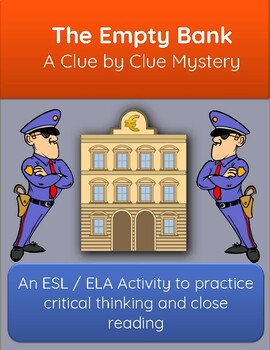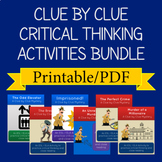Critical Thinking Mystery Activity: Empty Bank
- PDF
Also included in
- By popular demand, all my clue by clue mysteries PDF (printable) format in one big bundle, plus a free mystery story organizing worksheet. Be sure to check the list above to see the exact list of Clue by Clue Mysteries!Each individual mystery is in PDF format and contains:A cover imageComprehensivePrice $90.00Original Price $123.00Save $33.00
Description
In this fun mystery activity that encourages discussion and critical thinking, students have to solve an odd riddle--why did 10 police drive up to a bank and surround it in the middle of the night, even though no one was inside! Can your students follow the clues to figure out what happened? They'll need to use logic and close reading to figure it out!
The PowerPoint format makes it easy to share face-to-face in class or in online classes, distance learning, or remote learning (whatever we're calling it now)! You can also easily import it in Google Slides and use it in Google Classroom!
Click here for the PowerPoint version of The Empty Bank.
What is a Clue by Clue Mystery?
It's a great warm-up, filler, or time killer for early finishers. Students are given a mystery to solve--whodunit or how did they do it or why. They have to figure it out by reading a series of clues, one at a time. As they receive each clue, they speculate on its significance and what it tells them about the situation.
Once they have received all the clues, they should have enough information to figure it out!
Inside find:
- Teacher Notes on how to use the clues, including suggested warm-ups.
- 7clues to be given to students one by one.
- Hints in the form of guiding questions to help students figure out what happened.
- The Solution: Students are not left hanging. There is a clear solution that follows from the clues. No gimmicks, no tricks, no need to know obscure facts.
Clue by Clues make great warm-up activities, fillers, or time killers for those last minutes of class and early finishers. They can be critical thinking and close reading activities that teach students to look for details, synthesize information from different sources, apply prior knowledge about the world, and to recognize the logic of a claim and evaluate its validity.
While students are solving the mysteries they are also developing their spoken language skills, using language such as:
- Modal verbs of speculation: She must have forgotten her keys, It could have been the butler
- Opinion language: I think...., I’m positive..., I’m not sure...
- Hedging: It’s possible, probably, maybe, it’s not impossible.
- Conclusions: That means that...
- Emphasis: There’s no way that...
- Hypotheticals: What if he didn’t do it, If he was at the movies, he couldn’t have done it.
They are also a lot of fun!
Teacher Notes on how to use them are included with hints and the solution.
A students sheet that contains the clues for you to copy and cut up to give to students. There are also some extension questions to keep the discussion going and ideas for further projects!
Enjoy this? Check out my entire Mystery Section with more clue by clues in different formats. I also have activities to help students write their own mysteries and more!
And please leave a review. It helps others find this resource and gives me valuable feedback when creating new ones!






